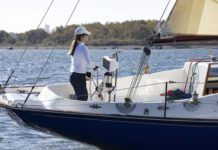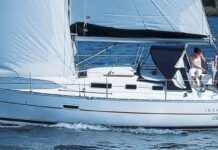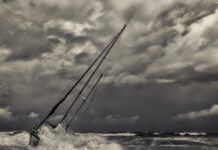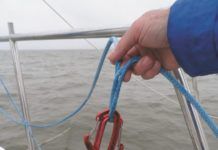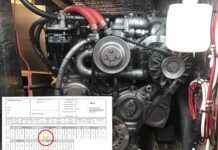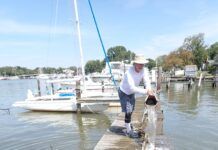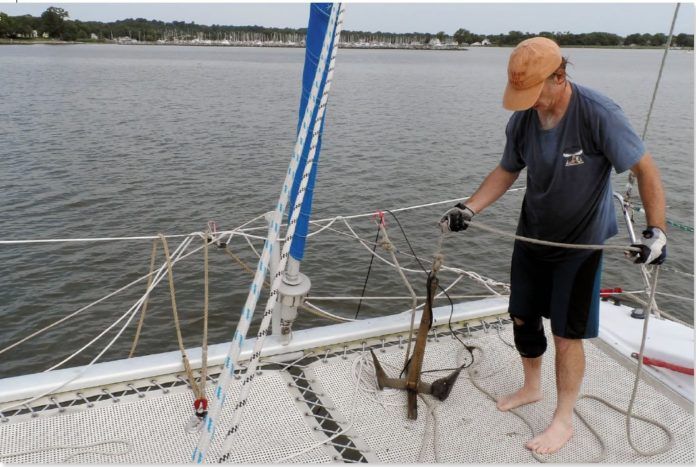Recent tests on a miserable holding bottom in the Chesapeake Bay (see PS, February 2015 online) showed that conventionally sized anchors just don’t hold in a soupy bottom. Those that can-pivoting fluke anchors-arent always the easiest to set, and security during wind shifts is much debated. Setting a second anchor is an option-one weve studied previously (see Tropical Storm Dos and Donts, PS November 2011 online)-but tandem rigs intrigued us. Could two anchors on a single rode provide more secure holding in tricky bottoms, and if so, what is the ideal arrangement? We were particularly interested in single-line tandem rigs (which Rocna designer Peter Smith referred to in his report) and V-tandem rigs (which several PS contributors have had success with).
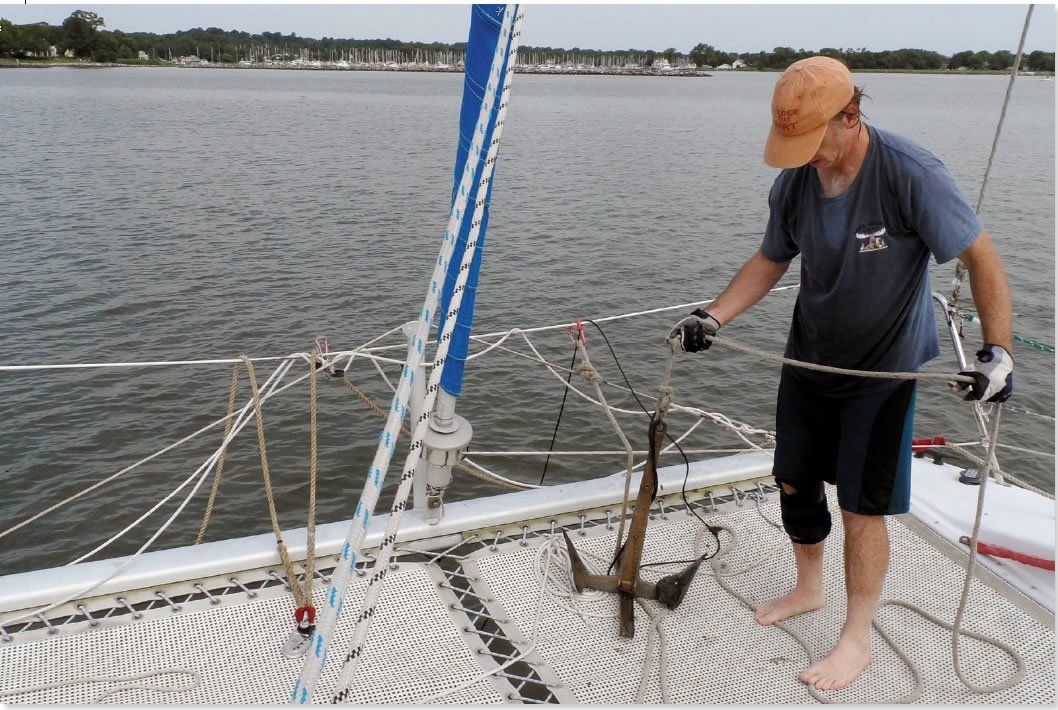
The tandem rigs described here are for exceptional situations. They are not, by any means, a replacement for the conventional single working anchor, which should hold in most anchoring situations. If you are routinely having problems anchoring with your working anchor, it is time to review your equipment and technique.
Practical Sailor has tested the most popular anchors in a variety of bottoms. Weve also reviewed a wide range of anchoring equipment-ranging from snubbers to shackles. These articles can be found in our online archives, as well as in our four-volume Anchors ebook available in our online bookstore.
Why bother with two anchors on a single rode? Is this practical? We operated from the premise the casual cruiser doesn’t carry a storm anchor or specialized gear for a tandem rig, but yet might find themselves unavoidably stuck in an anchorage where normal anchoring procedures likely wont work. We sought a rig that could be assembled with what most people have on board and would be practical to set as a second anchor on its own separate rode. It needed to be a 10-minute solution. Keep in mind that this article is looking almost exclusively at the holding ability of various tandem arrangements; the more practical, real world issues will be addressed in Part 2.
What we tested
This report is Part 1 of a two-part test. Part 1 looks solely at small anchors to monitor behavior and try different anchor types and rode configurations. In Part 2, well look at the actual performance and practical considerations for the most promising configurations using full-size working anchors suitable for boats 30 to 35 feet long.
Instead of focusing on specific anchor models, we focused on trends driven by rigging geometry: which two-anchor rig is better, by how much, and why; and which is practical to deploy. We used a Lewmar Claw (similar to a Bruce anchor and its lookalikes), the Mantus dinghy anchor (a newer, deep-set design similar to the Manson Supreme, Spade, and Rocna, etc.), and the Guardian (a pivoting fluke design similar to the Fortress, Danforth, and their lookalikes).
How we tested
We tested in three representative sea bottoms in Chesapeake Bay: gravelly beach sand (Sandbox, Great Falls, Md.) for ease of photography and to work out our systems; fine, firm sand (Herring Bay, Chesapeake Bay) to test high load holding; and typical soft creek ooze (Rockhold Creek, Deale, Md.) for a taste of the real world. Because the beach sand exercise aimed only at evaluating the behavior of various tandem rigs, we did not measure forces on the gravelly beach.
The key data was collected with in-water testing from a moored or docked catamaran using the primary winches to increase tension. The test rode was a 6-foot chain leader with a polyester rode at 10:1 minimum scope (20:1 for single line tandem rigs) and thin polyester slings for secondary rodes. We tested each rig three times, recording the maximum force at 0, 30, 60, and 90 degrees to the original direction of set.
For the sake of clarity, well refer to the anchor that is closest to the boat as the primary anchor, which is set from the primary rode. The secondary anchor is the furthest away from the boat. The secondary rode attaches the secondary anchor to the primary rode or to the primary anchor.
In some test rigs, we used an anchors tripping or tandem hole for attaching the secondary rode. The tripping slot is located high on the shank on the fluke end of the anchor and is intended for extracting stuck anchors only. A tandem hole is located at the fluke end of the shank at the level of the fluke, or in the center of the aft edge of the fluke. Few anchors have tandem holes, so they must be drilled. The tandem hole is small, so it should not compromise strength as long as its placed in a non-structural location. Even though the galvanized coating is compromised during drilling, corrosion is controlled by surrounding zinc and the galvanized shackle.
We tested four rigging arrangements: secondary rigged to tripping hole; secondary rigged to tandem hole; secondary rigged to primary shackle; secondary rigged to the main rode about one boat length (6 feet for small anchors) above the primary anchor with lengthened secondary rode (very shallow V angle with asymmetric legs). None of the rigs using the tripping hole were successful; it should be used for tripping only, in our opinion.
We tested six anchor pairs: two Claws together; a Claw primary and Guardian secondary; Mantus primary and Guardian secondary; Mantus primary and Claw secondary; Claw primary and Mantus secondary; Guardian primary and Mantus secondary. The accompanying illustrations, Tandem Options, show the most promising configurations. In all cases, we made sure the anchor was well set and stopped pulling at 700 pounds to avoid equipment damage. The 700-pound maximum is a lot for a 2-pound anchor, and when scaled up to full-size, it exceeds the breaking strength of the chain rode and so it was accepted as a passing performance.
We supplemented the controlled tests with tests in the field. We put the rigs to use aboard one of our test boats, an 8,000-pound catamaran, monitoring the load to see whether the loads in our controlled testing were realistic.
Observations
When placing two anchors on the same rode, try to leave enough slack between them so that the primary anchor can set first; if the secondary sets first, the primary will never set properly unless the bottom is quite soft and you are already dragging-a bad thing. Lower the anchors until the secondary touches, continue backing until the still-slack rode is at a 30- to 45-degree angle, and then quickly lower the primary away. There is, of course, some chance that the primary will foul on a pile of chain. That happened to us several times, and testers never fully overcame these problems at either test or full scale.
For uniformity, we hand-placed the anchors for all data-producing runs. In the real world, proper deployment of single-line tandem rigs on sand or soft bottoms is dubious; you just can’t see or tell what youve set in muddy conditions.
Inline using tandem hole
Testing various inline tandem rigs with the secondary connected via the tandem hole, we were only marginally successful when using the double Claw setup or the Mantus in front of a Claw (our softest anchor) in soft bottoms where the anchors could both dig in and rotate easily. Results were very poor when using the Mantus or Guardian as a secondary and the Claw as primary; the primary was lifted at relatively low load every time and would not reset. Even the Mantus in front of the Claw was less stable than a Mantus alone. Except for straight-line testing in perfect bottoms under controlled conditions, we could not find a single combination that was better than the larger single anchor, and in most cases, it was much worse. The smaller secondary anchor would hold while the primary would lie on its side, unable to reset. Using an inline setup, you are balancing some potential for increased holding against a substantial risk of greatly reduced holding.
Bottom line: For soft bottoms, inline tandem anchoring using the tandem hole is a bad bargain.
Inline using primary shackle
In the absence of a tandem hole (only Rocna has this), the secondary rode can be attached a few links above the primary shackle. If the primary is not well buried, the secondary rode can trip the primary as it drags across the bottom. Like the tandem-hole rig, the scope must be 20:1 when using the shackle setup; this rules out use in deep anchorages. This rig responds a little better to wind shifts, as the primary anchor is free to rotate rather than encouraged to roll-out by secondary rode tension.
Never use a pivoting fluke (Danforth-style) anchor as any part of a single-line tandem system. The setting is not reliable enough in a system where independently confirming the set of each anchor is impossible. If using a pivoting-fluke anchor as primary, there is no means to rig a secondary, and even if you could, it is too slow to drag to share any load with the secondary. As the secondary, it will hog the entire load and lift the primary out of the bottom like a kellet; it did this every time in testing.
Bottom line: Inline tandems are not recommended for soft bottoms, but as well discuss in more detail in part two of this report, they can be a suitable choice in some circumstances.
V Tandems
There are many variations in the tandem V setup, starting with the shackle-rigged, single-line tandem described above (the rode connecting the primary anchor to the main line is zero length) and finishing with the Bahamian moor (see illustrations), where the connecting rodes are equal length and the anchors are of equal size. Our focus is on V tandems with asymmetrical legs of about one to two boat lengths.
The reason for asymmetry is improved compensation to changes in wind direction; the primary need only drag a short distance-often less than the distance needed to build full holding power-before it can effectively share the load, making it much more robust and stable than either the single line or the Bahamian moor, a symmetrical V. A leg-length ratio between 2:1 and 3:1 was most flexible; we used 2:1 for testing.
There are two general anchor arrangements for the tandem V: the stronger anchor further away and the stronger anchor closer. Orientation is also controllable. You can arrange a wide V in the direction of an anticipated wind shift or have one rode oriented toward the existing wind, allowing the rig to adjust. Setting the stronger anchor further away is best if no wind-direction change is expected, just behind the theoretical inline tandem. It is easier to set the weaker anchor further away, but the preference is to orient the stronger anchor in the direction of the anticipated shift, if at all possible. If they are set as a V in the direction of the anticipated shift, it does not seem to matter which anchor is further away. If there is uncertainty regarding the wind shift, and there is room, setting the stronger anchor farther away is more conservative and adjustable.
The main vulnerability of all tandem rigs is fouling. Do not use a single-line tandem if 360-degree wind shifts are expected; they will foul. Asymmetrical V tandems are vulnerable to the primary tripping, if it is not well buried and the wind shifts 180 degrees. The symmetrical Bahamian mooring will rarely foul, but it is not as strong, since one or the other is taking the load (except in a 180-degree wind shift).
All V-moors are vulnerable to rode twisting. If 360-degree shifts are expected, one option is to attach the secondary rode to the main rode at least six feet from the roller, so the chain can absorb the twist, and untwisting is simplified. These rigs are not meant to be left untended for a long time, so multiple twists should not be a major problem.
Bottom line: Asymmetrical V-shaped tandem rigs show promise in soft-bottom anchoring situations.
Data Review
When we extrapolated our findings to fit a 34-foot cat and the 12- to 35-pound anchors we actually use (see accompanying sidebar), the consequences were surprising. (Anchor arrangements below are listed as primary/secondary.)
Soft mud
In soft mud, the Claw will drag first, the Mantus will drag more slowly, and the Fortress normally holds. Though we are not always comfortable using a Fortress in wind shifts, it has a good holding record in deep, soft mud. Among the tandem rigs, the best single-line rig, the Mantus/Claw combination, will drag as soon as the wind shifts and offers no advantage over a single Mantus. The Mantus/Mantus V tandem may drag, and the Mantus/Guardian V tandem showed the most promise in all conditions.
Sand
In sand, the Claw is more prone to dragging, the Mantus should hold well, and the Fortress should hold well, but may be vulnerable to wind shifts. The inline tandem setups in sand were more vulnerable in wind shifts than single anchors. All of the V-tandems should hold, with the Mantus/Guardian tandem being sufficiently secure to break the chain.
Field Testing
We anchored a 32-foot, 8,000-pound catamaran using both inline- and V-tandem rigs (built with 2-pound anchors) in moderate to breezy conditions in firm sand. Peak loads were recorded. The max setting power of twin 9.9-horsepower Yamaha high-thrust outboards was 260 pounds. Even with 20:1 scope, the single-line tandem dragged.
The V-tandem, on the other hand, rotated to face the force every time. The Mantus/Guardian pair was stable up to 15 to 20 knots, with peak loads of up to 450 pounds observed. Surging and yawing had no effect. We never tripped anchors since both could be set independently. When we extrapolate this to full-size anchors, the holding power is impressive, well above the anticipated loads in a 60-knot storm (even in mud) and strong enough to break the chain in sand.
Conclusions
Our study has been relatively narrow-uniform sand and very soft mud bottoms with just a few anchor types-but there are a few clear lessons. Ultimately, we found that tandem anchor rigs exhibit the same general trends in mud versus sand, though the holding in soft mud is far less. If a rig is unstable in sand, it will be unstable in mud.
Single-line tandem: This approach is not applicable for soft bottoms, but it can be useful in other scenarios, as well discuss in Part 2. Anyone trying this approach should use at least 20:1 scope (based on secondary anchor) and use the better setting and holding anchor as a primary.
V-tandem: When using a V-tandem, 10:1 scope is sufficient. Make sure the primary is completely buried; the secondary rode can trip the primary, if the wind shifts in that direction and anything other than the roll bar is exposed. Asymmetric legs result in more holding power and more stable dragging.
In V-tandem rigs, the two anchors complement each other, and each is allowed to do what it does best (dig in, rotate, etc.). Place the higher holding power anchor farther from the boat, allowing the primary to buffer the wind shift and the secondary to hold.
If shifts in tide or wind make rotation of the boat likely, terminate the secondary rode onto the main rode; untwisting is much simpler than if both rodes extend into chain lockers. Do not use V tandems for long stays as the chains will wrap around each other. Even in very soft mud, a V tandem of appropriately sized anchors should hold in storm winds, particularly if one is a Fortress.
In Part 2 of this report, we will test what we learned in the shallows with small anchors in the field with full-sized anchors.

The purpose of beach testing was to get a feeling for how the setups would behave. Inline tandems always trip; V-tandems are stable, but require well-set anchors to prevent tripping.
1. When a stronger anchor (in this case, a pivoting fluke Guardian) is the secondary of an inline tandem, it will lift the primary out of the bottom, converting it into an expensive kellet. Even a small anchor can do this, depending on the bottom type and exact setting conditions. In testing, a 12-pound Northill secondary did this repeatedly to a 35-pound Manson Supreme in sand, neutralizing the effectiveness of the larger, better anchor.
2. If the primary anchor in a V-tandem setup is not well-buried, it can be tripped when the rode drags past it.
3. This inline tandem appears to be functioning, with the primary anchor buried and the secondary following along.
4. But as soon as the wind veers, the primary rolls out, is pinned on its side by secondary rode tension, and will never reset. Only a 20-degree veer is required for this to happen.

The Fortress is the undisputed king for high holding in soft bottoms, but it is not particularly good when faced with dramatic changes in pull direction. In soft-bottom anchoring, new-age anchors readily align with changes in the direction of pull. While, these anchors are not as strong as a Fortress in absolute terms, but they are far more adaptable. The goal of tandem anchoring is to exploit the power of the Fortress while using one of the newer, deep-setting, single-fluke designs such as the Mantus, Manson, Rocna, or Spade to support and protect it from dramatic changes in direction.
It is important to minimize the amount of dragging required for equalization; even the most stable anchor can be deflected or tripped by trash in the mud, if it drags far enough.
1. In Bahamian mooring, the boat’s motion is limited to the center ellipse; the anchors cannot foul; and they don’t have to reset with wind or tide changes. However, the rig is no stronger than the weakest anchor; it is a poor choice for soft bottoms.
2. When the wind shifts or the force becomes too great in the asymmetrical V-tandem setup (soft bottom), the weaker anchor follows the wind and equalizes the load. The Fortress stays put, turning slightly. This is the strongest set for soft bottoms using a deep-set, single-fluke anchor with a Fortress kedge.
3. When a storm is anticipated, it can make a lot of sense to set the Fortress in the direction of the anticipated blow in an asymmetrical V-tandem setup. The deep-set, single-fluke anchor will shift to equalize the strain.

1. Inline tandem anchor rigs held some promise in a straight line, but as soon as the direction of pull changed, the primary anchor popped out, and only the secondary Lewmar Claw held. When the Mantus was the primary anchor, this resulted in a big loss. When the rig used the Claw as both the primary and secondary, the setup did not perform much better than when testers used a single Claw. The results were the same in sand, but there was better holding; as soon as the direction changed, the primary popped out and remained pinned on its back.
2. V-tandems were stable in all direction shifts—the total hold being the sum of individual strengths less a minor geometry penalty. In all cases, the primary anchor exhibited stable dragging while equalizing; it is vital that the primary anchor be the most stable and have good rotation behavior. The results were the same in V-tandem anchoring in sand, only more reliable; reliability depends heavily on clean substrate, without odd layers of shells or sticks that could deflect or trip an anchor.


